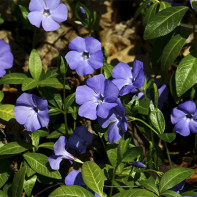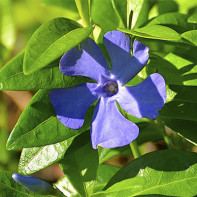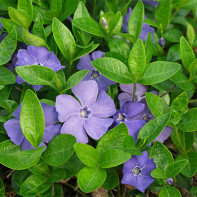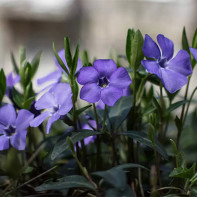Periwinkle: medicinal properties and contraindications
Nature gave the periwinkle amazing vitality. He is not afraid of frost and heat, grows on poor soils, skillfully dodges strong winds, falling to the ground. According to legend, it has mystical properties, it is able to scare away evil spirits from housing, and neutralize negative energy. The girls handed the wreaths with this flower to the chosen one, attached them above the door and kept them as a talisman, after drying several blue corollas. The medicinal properties of the plant are especially appreciated, so it is often planted in summer cottages and household plots, receiving a bright flower bed and medicinal raw materials.
- How it looks and where it grows
- Kinds
- Collection and storage
- Chemical composition
- The healing properties of periwinkle grass
- Periwinkle in folk medicine
- Potency tincture
- Infusion for hypertension
- Collection for the treatment of vegetative-vascular dystonia
- Weather sensitivity and migraine
- Atherosclerosis
- Diarrhea, dysentery
- Infertility
- Skin diseases, wounds, insect bites
- Diathesis
- Application in cosmetology
- Periwinkle preparations
- Contraindications
How it looks and where it grows
Periwinkle has several more names that reflect its properties or appearance. So it is called a tinea for coloring flowers, a burial ground for addiction to living in cemeteries, ivy. The Latin name comes from the verb "wrap". Indeed, the creeping shrub willingly climbs to a considerable height, using any vertical or inclined base for support. Some grassy species have an erect stem with a flower on top. The leaves are dense, covered with a film that protects them from drying out. They are able to maintain green color even under snow, and in the spring they begin to bloom among the primroses. The flowers are blue, large, with shrubs located mainly in the axils of the leaves. The main shade is blue, sometimes there are varieties with white, purple or pink flowers.
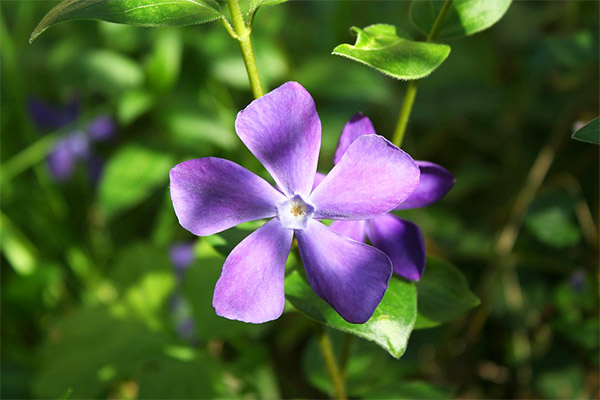
Interesting: the plant survivability is so high that, taken out of a vase in a semi-wilted state and placed in moist ground, it quickly comes to life and takes root.
The titanus blooms in May, the shape of the corolla is funnel-shaped, they open gradually. On flowering specimens, fruits are formed in the form of two long leaflets. In nature, there are 4 main species, but breeders have developed several more decorative varieties that, having acquired a more magnificent appearance, have not lost their medicinal properties.
The plant is so unpretentious that once it gets to a new place, it instantly takes root, and it is very difficult to get it out of there. In the wild, grows in Europe, Africa, Asia. It is found in most of the territory of Russia, taking a fancy to roadside lanes, deciduous forests. The branches of a shrub cover the ground with a continuous carpet, quickly rooting due to stem nodes.
Thanks to its tremendous vitality, the flower began to be planted in cemeteries as a sign of memory and fidelity. It does not need special care and grows well there, being content with rains as watering.
Kinds
In total, there are about 12, it’s more difficult to say, since new variations are constantly being discovered that scientists have not yet classified. 5 species are well known and loved by gardeners.
- Large. It is named for outstanding dimensions. Vertical shoots stretch 150 cm up, the leaf plates are deep green in color, wide. The color of the flowers is blue with a contrasting light center, the diameter of the corollas reaches 5 cm. It grows rapidly, is insensitive to the level of lighting, and can grow in shaded places. In winter, to protect the root system requires additional shelter with spruce branches.
- Small. Frost-resistant species has an amazing ability to adapt to a new place. It belongs to the evergreen group, since the leaves are preserved under the snow. It differs from other species in a denser and more frequent planting of dark green oblong leaf plates.It blooms in May, with proper care, it is able to form buds a second time, in autumn. The color of the flowers in the classic version is blue. Ornamental varieties with white, red, variegated, bordered flowers of a simple and terry shape are bred. The shade of the leaves can be silver or motley. Unpretentious to the composition of the soil, easily rooted on stony slopes, in pine and mixed forests.
- Pubescent. Most often found in the Caucasus and in Primorye. It features an increased regeneration rate and the ability to root in a short time on virtually any soil. It does not tolerate cold, the leaves die off in winter, blooming under the first warm rays in early spring. It blooms in May, the diameter of the flowers is up to 3.5 cm. Young stems form all season until late autumn. So that they do not freeze, they insulate the flowerbed for the winter.
- Herbaceous. It grows in Crimea, Europe, in the Caucasus. It grows well on elevated sunny hillocks, does not like the close presence of subsoil waters, avoids wetlands. The flowers are blue, five-petalled, with narrowed tips. They bloom for 20–25 days, then seeds are formed.
- Pink. Differs in plentiful vertical shoots rising up to half a meter in height. On dark green leaves, a longitudinal light strip extending from the petiole to the tip is clearly distinguishable. Flowering is long, starting in May and ending in early September. The blooming periwinkle is a soft pink carpet on a contrasting green background of leathery leaves.
Of the decorative varieties, gardeners enjoy the greatest love:
- Reline Cooler;
- Mediterrane;
- Cascade Appleblossom.
It is grown from seeds. The tin leaf grows rapidly, forming a continuous carpet. In landscape design, it goes well with primrose, medunica, forget-me-nots. When planting, you must immediately limit its growth zone, otherwise the shrub instantly turns into an omnipresent weed.
Collection and storage
When harvesting medicinal raw materials, it is very important to comply with deadlines. The napkin is gaining its main strength during the flowering period, which is why they collect it in early June, cutting off shoots at a height of 4-5 cm from the ground. Most often, a small periwinkle is harvested; mixing with other species is undesirable; they are collected and dried separately.
It is worth considering: harvesting at one place is carried out once every 3 years. With a more frequent visit, the plant population does not have time to recover and becomes weakened, with a reduced amount of nutrients.
Dry the green mass with the flowers in a shaded, well-ventilated place. You can use the electric dryer in a mode not exceeding 50 degrees.
Chemical composition
The leaves and flowers contain more than 20 types of alkaloids, for which it is valued by herbalists when compiling fees aimed at alleviating the condition of cancer patients. In addition, the composition of the ground part of the plant includes:
- ascorbic, succinic, malic acid;
- Sahara;
- phytosteroids;
- triterpene saponins;
- bitterness;
- pectin;
- carotene;
- flavonoids;
- cardiac glycosides.
Important: the plant is poisonous, uncontrolled intake without observing the dosages and proportions in the recipes is dangerous to health.
The healing properties of periwinkle grass
The use of periwinkle is very wide. It was not in vain that they took him under protection and do not recommend pulling out plants with roots or completely destroying an overgrown meadow when harvesting. Despite his phenomenal ability to root and reproduce, he simply does not have time to recover from uncontrolled collection.

The plant has a vasodilating, antimicrobial, calming, astringent effect. It can inhibit the development of cancer cells, relieve chronic pain and inflammation, reduce blood pressure, stabilize the genitourinary and cardiovascular system.
Based on extracts and extracts from the plant, drugs are produced. Reception of decoctions and infusions is recommended:
- with frequent vascular spasms, headaches, migraines;
- vitamin deficiency;
- fragile walls of blood vessels;
- hypertension
- circulatory disorders;
- diseases of the respiratory system;
- indigestion
- neurosis, emotional instability, depression;
- osteochondrosis;
- atherosclerosis;
- increased intracranial pressure;
- atrophic changes in the fundus and retina;
- feverish conditions;
- sexual weakness;
- brain diseases.
A good effect is given by rinsing with a decoction for toothache and bleeding gums. It is used as part of complex therapy in the treatment of infertility, chronic inflammation of the ovaries.
Periwinkle in folk medicine
The plant is included in the official register of medicinal herbs. Dried raw materials are sold in pharmacies, a tincture is included in the complex fees for hypertension, stomach ulcers and vegetative-vascular dystonia. Some healing products can be prepared independently, carefully observing the proportions and manufacturing technology. The use of decoctions and infusions for the treatment of female diseases gives excellent results, for which in ancient times he was credited with magical properties.
Interesting: one of the names for the small periwinkle is witch violet.
There are many recipes for healing compounds, they can be conditionally divided into decoctions, water and alcohol infusions, ointments.
Potency tincture
For cooking, take 100 g of dry raw materials per 500 ml of medical alcohol. The grass is poured and insisted for 14 days in a dark place. To better dissolve the nutrients, the container is shaken daily. Dosage is in drops, 5 at a time. They are diluted in 1 tbsp. a spoonful of water. Take twice a day. The maximum dosage is 10 drops per day. The course is 4 days, then you need a break for 2 days. Three approaches are required. The tool has a cumulative effect, so tangible results appear only at the end of the course of treatment.
It is worth considering: for alcohol and water infusions, the grass must be carefully crushed to enhance its effect.
Infusion for hypertension
On a glass of boiling water take 1 tbsp. spoon of dried periwinkle and put in a water bath, incubated for 15 minutes. After the broth has cooled to room temperature, it is filtered, the grass is squeezed. Divided into equal parts and taken three times a day.
Collection for the treatment of vegetative-vascular dystonia
In equal shares mix:
- periwinkle and viburnum leaves;
- valerian root;
- bark of viburnum.
In 6 tbsp. tablespoons of the mixture add 3 tbsp. tablespoons mistletoe and 1 seed of caraway seeds. After thorough mixing, 1 tbsp. a spoonful of the mixture. After filling it with 200 ml of boiling water, set in a water bath for a quarter of an hour. After that, they stand for 45 minutes under warming, filter, squeeze the raw materials and add to a glass. Reception is 100 ml 3-4 times a day before meals. The duration of the course is 3-4 weeks. At this time, it is advisable to revise the diet, reducing the amount of salt consumed and replacing sugar with honey.
Weather sensitivity and migraine
With age, people become more susceptible to fluctuations in atmospheric pressure, and it is difficult to endure a sharp change in weather. Some take off for age, not wanting to bother looking for a medicine. And it is literally under your feet.
1 teaspoon of dried witch's violet is brewed with a glass of boiling water and left under a towel for 20 minutes. Take 1 tbsp. spoon half an hour before meals, the duration of treatment is 30 days.
Important: the shelf life of the broth does not exceed 48 hours.
Atherosclerosis
With this disease, the intensity of the blood supply to the brain is disturbed. The effectiveness of periwinkle is explained by the presence of special alkaloids that stimulate blood flow. In a water bath, prepare a decoction of 1 tbsp. spoons of periwinkle and a glass of water. Then the volume of liquid is adjusted to 200 ml and taken in equal parts during the day before meals. After a break of 10 days, the course is repeated until the blood pressure indicators stabilize. According to the same scheme, hypertensive crises are prevented.
Diarrhea, dysentery
The broth is prepared in a proportion of 1 tbsp. tablespoon of raw materials in 300 ml of water. Then it is kept for 20 minutes over low heat, cooled, taken 100 ml 3 times a day until the intestines normalize. The tool is also effective as a rinse for sore throat, stomatitis, bleeding gums.
Infertility
The problem is very serious, and you should not completely rely on pharmacy drugs. Combined therapy with herbal infusions that normalize the tone of the uterus gives a better result. 1 teaspoon of the napkin is crushed into powder and pour a glass of boiling water. Stir without filtering.Take 6 times a day, one sip of 14 days.
Skin diseases, wounds, insect bites
Outside decoctions are used to wash cuts and scratches. Lotions are applied for 15 minutes with weeping dermatitis, eczema, ulcers, burns, psoriasis, dermatitis.
When biting mosquitoes and midges, it is enough to wipe the skin area with a cotton pad or cloth dipped in a decoction of small periwinkle. Within a few minutes, the itching subsides, swelling subsides.
Diathesis
Periwinkle is used for the preparation of ointments for external use. What is needed is fresh leaves that have not lost juice. They are ground, combined with 20 g of butter and melted. Then let it cool slightly, filter through cheesecloth and pour into a jar. Store in the refrigerator. Children are smeared with sore spots once a day, adults are allowed to double the dosage. More often, the remedy is not used, since the plant is poisonous, and instead of benefit, you can harm yourself.
Application in cosmetology
The alkaloids in the composition of the witch violet stimulate cell regeneration, improve complexion, and support skin turgor. A decoction of 1 teaspoon per glass of boiling water is called rejuvenating for its powerful effect on the epidermis. They are simply washed or made with warm compresses, applying a cotton napkin soaked in liquid to the face and décolleté. Invigorates and reduces wrinkles a cube of ice from a broth of periwinkle.
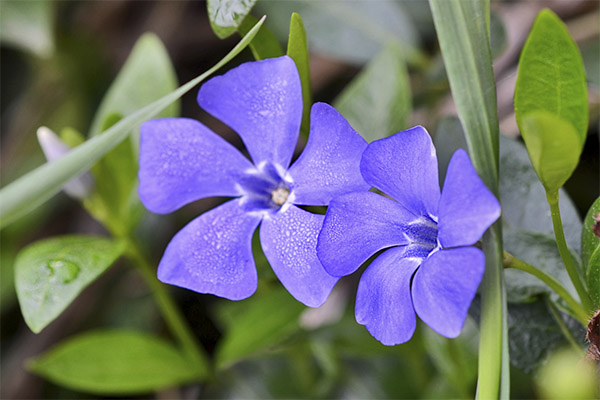
The pinus does not irritate the tender skin of the eyelids and around the eyes. This property has been successfully used to care for her, relieve fatigue and stress after a hard day.
Periwinkle preparations
The main value for pharmacology is the alkaloid vincamine, extracted from the periwinkle extract. It has beneficial effects on the vessels of the brain, restoring the intensity of blood flow, preventing the onset of ischemia and atherosclerosis. It normalizes the metabolism, stimulates the activity of neural connections, helps to increase concentration, increase efficiency, relieve stress without the effect of inhibition. Based on the unique alkaloid, drugs are produced aimed at normalizing brain functions, increasing the permeability of capillaries, improving memory and attention, relieving symptoms of speech delay and constant headaches provoked by emotional overstrain. These medicines include:
- Vinpocetine;
- Cavinton;
- Oxybral;
- Vincapan
- Vinebral.
Contraindications
Before using tools based on a ningilicum, it is necessary to undergo an examination by a cardiologist. The fact is that some of the substances that make up the green mass of a plant have a depressing effect on the heart muscle, and the possibility of complications must be excluded in advance. The benchmark will be a decrease in heart rate. In this case, the course of treatment with decoctions or preparations based on periwinkle is stopped.
You can not apply herbal preparations based on witch violets with bradycardia, chronic constipation, hypotension, brain tumors, allergies. During pregnancy and breastfeeding, it is also worth replacing the periwinkle with other means.
Need to know: drugs and folk remedies on the basis of the napkin actively remove fluid from the body. This alleviates the problem of edema, but can cause excessive dehydration.
Treatment is stopped if persistent nausea, dizziness, loss of appetite, muscle weakness, neuralgia have begun. Such phenomena signal a serious overdose or individual intolerance to substances.
It is worth planting a periwinkle in the garden or in the country, admiring its bright corollas of flowers and remember that at hand there is a powerful tool for maintaining beauty and health.
«Important: all information on the site is provided exclusively in fact-finding purposes. Before applying any recommendations, consult with a profile specialist. Neither the editors nor the authors are liable for any possible harm caused materials. "

